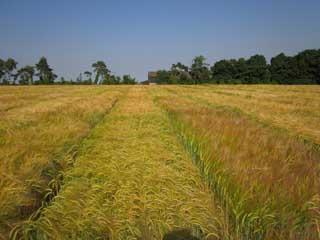The Journey from Genes to Plant Traits Reveal a Flexible Response to a Changing Environment
Published on 1 May 2014 in Climate, water and energy , Food, health and wellbeing

Introduction
To address the challenges brought about by the impact of climate change and our increasing reliability on plant based food, fuel and materials, requires an understanding of molecular processes that underlie crop responses to environmental stresses.
Based on the Scottish Government Rural and Environment Science and Analytical Services Division (RESAS) funded investment and research efforts, as well as those from other funders, we have established and continue to develop and utilise plant genomic, transcriptomic, post-transcriptomic, metabolomic and proteomic methodologies combined with smart plant phenomic (the systematic study of phenotypes on a genome-wide scale) trait screens to characterise flexibility in plant gene expression that allows plants to adapt to an ever changing environment.
These key technologies are discovering a wealth of new genes, gene functions and intricate gene regulation mechanisms, which will, via integration with plant breeding and the associated industries, help us understand and manage essential Scottish crops as they respond to the changing environmental setting.
Key Points
- Tools and technologies established to monitor changing patterns of gene expression.
- Simple visual and measurable phenotypic screens developed that show change in response to environmental factors.
- Genes in biochemical and signalling pathways identified that respond to changing environments.
- Gene messages are modulated through post-transcriptional and post-translational processes giving flexibility and mechanisms for rapid responses to the changing environment.
Research Undertaken
Genes are switched on or off according to the conditions or growth phase the plant finds itself. The route gene messages follow to produce observable crop characteristics is complex and is subject to various regulation mechanisms, modulating crop responses. The evolving development and establishment of sensitive tools and technologies is crucial if we are to quantify and measure variable molecular responses to changing environments and to different adapted traits.
- Microarray and next generation sequencing techniques are measuring the co-ordinated switching on and off of multiple genes in response to environmental changes and stresses on a scale unprecedented only a few years ago. More detailed high resolution techniques dissect the manipulation of the functional messages and monitor their adjustment. A new quantitative proteomic approach identifies proteins that are made in response to environmental stresses. These technologies underpin strategies to develop and manage new crop varieties such that they have the best opportunity to deal with seasonal changes, daily adjustments and weather extremes that can have devastating effects on crop yield and quality.
- Gene messages are naturally manipulated into multiple different message transcripts through a post-transcriptional process called alternative splicing. The discovery that the proportion of these alternatively spliced transcripts can respond rapidly to environmental change such that the correct level of functional message is delivered has important implications for optimal crop growth. Transcript levels are further manipulated by specific induction of a group of potent gene regulators called microRNAs. MicroRNAs from potato have been isolated after induction by environmental stresses.
- To identify how crops adapt and optimise their growth we have developed elegant phenomic screens including rapidly produced microtubers, visualisation of root structure differences in our crop populations or the utilisation of crop technologies such as remote sensing (for example, thermal imaging) systems that report on a plants condition in the field.
Future
To remain at the forefront of plant crop science and translate our knowledge to Scottish agriculture, we are evolving systems based approaches to science that exploits this wealth of diverse data that helps explain crop responses under different environments. The value of utilising ‘–omic’ technologies in crop species is a more complete understanding of gene expression and its regulation and effect on plant performance in the field and the impact on the associated downstream products and industries. Through these technologies and improved understanding we can look to switch on protective gene sequences, switch off repressive gene sequences and develop smarter plant management practices.
Policy Implications
The work has direct implications on policy in relation to food security and the adaptability of our national crop plant species both in the short and long terms. Scottish Government has an important role in ensuring accessibility to healthy, affordable food and drink and is implicit in the evolving food and drink policy; A Recipe for Success – Scotland’s National Food and Drink Policy. The work here addresses challenges affecting crop responses to a changing environment and ultimately impacts crop quality and yield. This is directly applicable to the recognition that developing a more sustainable food system needs to consider how food systems will respond to climate change. Scotland’s Climate Adaptation Framework document published in 2009 acknowledged the need for our agriculture to adapt which was further recognised by publication of Getting the Best from our Land: A Land Use strategy for Scotland in 2011, in pursuance of Section 57 of the Climate Change (Scotland) Act 2009.
Author
Dr Craig Simpson, James Hutton Institute craig.simpson@hutton.ac.uk
Topics
Climate, water and energy , Food, health and wellbeing





